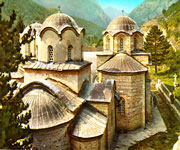The four edifices of the site reflect the high points of the Byzantine-Romanesque ecclesiastical culture, with its distinct style of wall painting, which developed in the Balkans between the 13th and 17th centuries. The Decani Monastery was built in the mid-14th century for the Serbian king Stefan Decanski and is also his mausoleum. The Patriarchate of Peć Monastery is a group of four domed churches featuring series of wall paintings. The 13th-century frescoes of the Church of Holy Apostles are painted in a unique, monumental style. Early 14th-century frescoes in the church of the Holy Virgin of Ljevisa represent the appearance of the new so-called Palaiologian Renaissance style, combining the influences of the eastern Orthodox Byzantine and the Western Romanesque traditions. The style played a decisive role in subsequent Balkan art.

Continent: Europe
Country: Serbia
Category: Danger
Criterion: (II) (III) (IV)
Date of Inscription: 2004
The Decani monastic church
The Decani monastic church is the endowment and mausoleum of Serbian King Stefan Decanski. The original founding charter from 1330 has been preserved. The construction lasted 8 years (1327-1335), and the master builder was Fra Vita, a Franciscan from Kotor. Stefan Decanski died before the construction was completed, and was buried here. Supervision of the construction works was continued by his son Dušan. The church interior was decorated at the same time, including the icons for the main iconostasis and the church furniture. The wooden throne of Hegoumenos was made around 1335, and the carved wooden sarcophagus of King Stefan Decanski around 1340.
 |
| Medieval Monuments in Kosovo Serbia |










0 comments:
Post a Comment